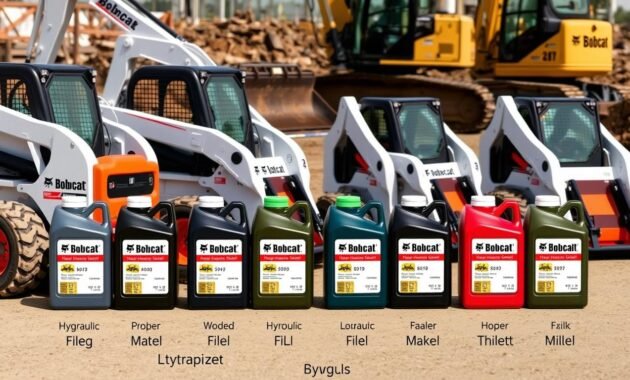Imagine your Bobcat equipment stopping suddenly because of bad hydraulic fluid. Construction workers and heavy machinery operators face big problems when hydraulic systems fail. The wrong hydraulic oil can lead to costly breakdowns, lower efficiency, and unexpected downtime.

Choosing the right bobcat hydraulic oil is key. I’ve learned that specialized hydraulic fluid is more than just a lubricant—it’s essential for your equipment’s life. With the right hydraulic oil types for Bobcat machinery, you can protect your investment, improve performance, and keep your site running smoothly.
The answer is in knowing the exact hydraulic oil ingredients and matching them to your Bobcat equipment needs. Every detail, from viscosity to additives, is important for top machine performance.
Read also: 303 Hydraulic Oil, What Is It ?
Understanding Bobcat Hydraulic Oil Fundamentals
Hydraulic systems are key to heavy equipment’s life. Knowing their parts is vital for the best performance. Bobcat hydraulic oils are essential for powering big machines, making them work smoothly in different places.
Keeping hydraulic systems running starts with knowing hydraulic fluid basics. The right hydraulic oil must meet tough standards to protect machines and keep them running well.
Basic Properties and Characteristics
Bobcat approved fluids have special traits that make them different from regular oils. They have:
- Non-compressible fluid transmission
- High thermal stability
- Corrosion and wear resistance
- Precise viscosity control
Role in Equipment Performance
Hydraulic fluid’s properties greatly affect how machines work. The oil does many important jobs:
- Transmits power between parts
- Lubricates moving parts
- Helps cool down
- Protects from contamination
Safety Considerations
Working with hydraulic oils needs careful safety steps. Risks include high-pressure injuries and contamination.
| Safety Aspect | Recommended Practice |
|---|---|
| Handling | Use protective equipment |
| Storage | Keep in sealed containers |
| Disposal | Follow environmental regulations |
Knowing these basics about hydraulic oil keeps your Bobcat equipment in great shape. It ensures your machines work at their best and last longer.
Essential Components and Base Materials
Bobcat hydraulic oils are made with care to keep heavy-duty equipment running smoothly. The heart of these oils is the base oil. It’s what makes the oil good or bad.
- Mineral-based oils from hydrotreated light naphthenic distillate
- Synthetic oils for specific needs
The type of base oil is key to how well a hydraulic system works. Most use mineral-based oils. They work well in many conditions. But, they get better with special additives.
| Base Oil Type | Key Characteristics | Performance Range |
|---|---|---|
| Mineral Base Oils | Cost-effective, standard protection | -20°F to 180°F |
| Synthetic Base Oils | Extended temperature tolerance | -40°F to 220°F |
Important chemicals like zinc alkyl dithiophosphate and naphthalenesulfonic acid calcium salt are added. They help protect the oil. This keeps the hydraulic system working well, even when it’s hard.
Types of Hydraulic Oils for Bobcat Equipment
Choosing the right hydraulic oil is key for Bobcat machines to work their best. Each type of oil has its own benefits for different conditions and needs.
What hydraulic oil to pick depends on several things. These include the Bobcat model, where it’s used, and what it needs to do. Experts must think about these factors before picking an oil type.
Mineral-Based Oils
Mineral-based oils are a classic choice for Bobcat gear. They work well in usual conditions.
- Good for temperatures that are not too hot or cold
- A budget-friendly option for many jobs
- Bobcat suggests them for most machines
Synthetic Options
Synthetic oils are top-notch for tough conditions. They keep Bobcat machines safe in extreme temperatures.
| Synthetic Oil Characteristic | Performance Benefit |
|---|---|
| Temperature Resistance | Stays thick in very hot or cold |
| Longevity | Needs changing less often |
| Equipment Protection | Keeps wear down in tough spots |
Specialized Blends
Some Bobcat machines need special oils for certain jobs. These oils are made for specific challenges.
- ISO 46 rated hydro fluids
- 10W-40 motor oil alternatives
- Automatic transmission fluid (ATF) for specific models
Always check your Bobcat manual and talk to a dealer before picking oil. Using the wrong oil can harm your machine’s hydraulic system.
Chemical Composition and Additives
Hydraulic oil additives are key to making Bobcat equipment work better and last longer. These oils are made with advanced additives that help machines run smoothly.

The heart of hydraulic oil’s success is its additive package. Anti-wear additives are very important. They create a shield that stops metal parts from rubbing together in high-pressure systems. This shield helps prevent wear and tear, making machines last longer.
- Viscosity index improvers stabilize oil performance across temperature ranges
- Antioxidants prevent oil degradation and chemical breakdown
- Anti-wear agents protect critical hydraulic system components
- Cold flow additives improve performance in low-temperature environments
Synthetic oils are made better than mineral oils. They have advanced additives that offer better protection and performance.
| Additive Type | Primary Function | Performance Impact |
|---|---|---|
| Anti-wear Additives | Reduce metal surface friction | Extended equipment lifespan |
| Viscosity Index Improvers | Maintain consistent oil thickness | Stable performance across temperatures |
| Antioxidants | Prevent oil degradation | Longer oil service life |
Additives make up 1-2.5% of hydraulic oil. These special chemicals are vital for keeping hydraulic systems running well in tough conditions.
Performance Requirements and Standards
Bobcat sets high standards for hydraulic oil in heavy equipment. This ensures machines work at their best. I’ve learned a lot about choosing the right oil for top performance.
Choosing the right oil is key for Bobcat machines to last long and work well. Knowing what oil to use helps avoid damage and keeps things running smoothly.
Viscosity Requirements
Viscosity is very important for Bobcat oil. It needs to match the temperature to keep everything lubricated and safe.
- Low-temperature viscosity ensures smooth start-ups
- High-temperature viscosity maintains protective film
- Consistent performance across temperature ranges
Temperature Range Specifications
Bobcat machines work in many different weather conditions. So, the oil must work well in cold and hot temperatures.
| Temperature Range | Recommended Oil Type | Performance Characteristic |
|---|---|---|
| -29°C to 0°C | Low-Viscosity Synthetic Blend | Exceptional Cold Start Performance |
| 0°C to 40°C | Standard Hydraulic Oil | Balanced Performance |
| Above 40°C | High-Temperature Synthetic Oil | Thermal Stability |
Pressure Tolerance Levels
Hydraulic systems face high pressures. Bobcat sets specific levels to protect parts and keep systems working right.
- Withstand high-pressure operational conditions
- Prevent system breakdown under stress
- Maintain consistent performance in demanding environments
Environmental Considerations and Eco-Friendly Options
The construction equipment world is moving towards greener hydraulic oils. Bobcat users are now choosing biodegradable hydraulic fluids. These options are better for the environment and keep equipment running smoothly.
Looking into eco-friendly bobcat oil, we find a few important points:
- Less risk of harm to the environment if spilled
- A smaller carbon footprint than traditional oils
- It makes heavy machinery operations more sustainable
- It works well with the latest Bobcat equipment
New makers are creating biodegradable hydraulic fluids from things like vegetable oils and synthetic esters. These new oils have big advantages:
- They break down naturally quickly
- They protect equipment from wear and tear
- They leave little to no toxic waste if spilled
- They perform as well as regular hydraulic oils
Choosing an eco-friendly hydraulic oil needs careful thought. You must make sure it fits your Bobcat equipment’s needs. These green options are a big step forward, but you must check they work right for your machine.
Read also: Expansion Tank for Water Heater
I suggest talking to Bobcat-certified techs. They can help find the best biodegradable hydraulic fluid for your equipment and how you use it.
Temperature Range and Viscosity Index
Hydraulic oil’s performance depends on its ability to stay consistent in different temperatures. Knowing the hydraulic oil temperature range is key for Bobcat machinery to work well.
The viscosity of hydraulic oil vs temperature is very important. It determines how well the oil works in different conditions. Hydraulic systems need oils that work well in cold starts and high temperatures.
Cold Weather Performance
In cold weather, hydraulic oils face big challenges. The viscosity index is key for smooth fluid movement. Important factors for cold weather include:
- Maintaining fluid flow at low temperatures
- Preventing system component stress
- Reducing startup resistance
- Utilizing anti-freeze additives
High Temperature Stability
At high temperatures, hydraulic oils must keep their protective qualities. Stability under heat involves several key factors:
- Preserving lubricating qualities
- Preventing viscosity breakdown
- Protecting against thermal degradation
- Maintaining system efficiency
Modern hydraulic oils have advanced additives for consistent performance in wide temperature ranges. The hydraulic viscosity index shows the oil’s ability to resist viscosity changes. This ensures reliable operation in different conditions.
Maintenance and Storage Guidelines
Keeping your Bobcat equipment in top shape is key. A good plan for oil changes and storing hydraulic oil can make your machine last longer and work better.
- Regular oil changes are a must
- Check the oil’s quality and for any dirt
- Keep hydraulic oil in a cool, dry spot
- Use clean containers when moving oil
- Watch the oil’s temperature and thickness
It’s smart to make a maintenance plan. Most Bobcat gear needs oil changes every 500 to 1,000 hours of use.
| Maintenance Interval | Recommended Action | Cost Estimate |
|---|---|---|
| Every 500 Hours | Basic Hydraulic Oil Check | $595 |
| Every 1,000 Hours | Comprehensive Oil Analysis | $1,850 |
| Bi-Annual | Complete System Inspection | $750 |
Storing hydraulic oil right is just as vital. Keep containers away from sunlight, keep temperatures steady, and avoid moisture. By doing this, you’ll get the most out of your Bobcat equipment.
Common Applications in Bobcat Equipment
Hydraulic oil is key for Bobcat equipment, making them run smoothly and efficiently. It’s vital for machines like skid-steer loaders, excavators, and utility vehicles. The right hydraulic fluid ensures top performance.
Working with Bobcat machinery, I’ve learned each type needs specific hydraulic oil. This ensures they work their best. Let’s look at the main uses and what each Bobcat machine needs.
Skid-Steer Loaders: Precision Hydraulic Performance
For skid-steer loaders, the right hydraulic oil is essential. It powers important functions like lifting and tilting. High-quality hydraulic fluid is needed for:
- Smooth lift and tilt mechanisms
- Optimal system pressure
- Less wear on moving parts
Excavators: Hydraulic Power in Action
Excavators need hydraulic oil for their complex movements. The right fluid ensures:
- Precise control of boom, arm, and bucket
- Less friction in the hydraulic system
- Longer life for important parts
Utility Vehicles: Versatile Hydraulic Fluid Applications
Utility vehicles use hydraulic oil for many systems. This includes:
- Power steering
- Hydraulic dump bed operations
- Functionality of auxiliary equipment
Recent research with 843 Bobcat owners shows the importance of choosing the right hydraulic oil. NAPA suggests using AW32 hydraulic oil. They highlight its anti-foaming properties and the need for quality fluid.
Compatibility with Different Bobcat Models

Choosing the right hydraulic oil for your Bobcat equipment is key. Not all oils fit all models. Each Bobcat model needs its own oil to work best and keep parts safe.
Knowing about universal hydraulic oils can guide you. Bobcat suggests several oils for their machines:
- Bobcat’s own hydraulic fluid (Part number 6563328)
- 10W-30 or 10W-40 motor oil
- Synthetic oils with ISO 46 rating
- Shell Rotella synthetic 10-40 motor oil
When picking oil for your Bobcat, remember these points:
- Look at your equipment’s manual
- Check the oil’s temperature range
- Make sure the viscosity is right
- Don’t mix oils that don’t match
It’s best to check with Bobcat dealers or tech support. Mixing synthetic and petroleum oils can harm your system or lower its performance.
| Bobcat Model | Recommended Oil Type | Viscosity Rating | Temperature Range |
|---|---|---|---|
| Skid-Steer Loaders | Bobcat Hydraulic Fluid | 10W-30 | -20°F to 90°F |
| Excavators | Synthetic Blend | 15W-40 | -5°F to 110°F |
| Utility Vehicles | High-Performance Fluid | ISO 46 | -10°F to 100°F |
Stick to the manufacturer’s advice to keep your warranty and avoid mechanical problems.
Read also: Bobcat Hydraulic Fluid for Protective Coating
Conclusion
Choosing hydraulic oil for Bobcat equipment needs careful thought. My research shows Bobcat’s branded oil is top-notch but pricey. It’s about three times more than brands like Super Tech or Coastal UTF. Owners must balance quality with cost.
Bobcat maintenance goes beyond just the right oil. It’s about knowing viscosity, temperature, and compatibility. I suggest looking into Shell Rotella T Heavy Duty Motor Oil or Napa Premium Heavy Duty Tractor Hydraulic Fluid. They offer great benefits without harming your machine.
Being flexible and informed is key. Whether it’s Bobcat 753 or other models, knowing oil specs is vital. Synthetic and synthetic-blended oils last longer and work better in cold, making them good for those watching their budget.
Your equipment’s life depends on smart maintenance choices. By considering manufacturer advice, performance needs, and cost, you can keep your Bobcat running smoothly.


